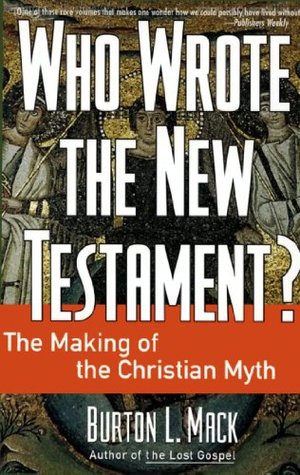More on this book
Kindle Notes & Highlights
Read between
August 24, 2020 - July 13, 2022
the Gospel of Thomas
The Coptic manuscript is a translation from an original Greek text that scholars date during the last quarter of the first century.
The Thomas people, like the Q people, were interested only in Jesus’ teachings. They thought of themselves as the True Disciples of Jesus.
Jesus treats their interest in the future as a gross misunderstanding of his teaching and goes on to explain that the kingdom is already present.
It is extremely important to see that the Thomas people developed the mythology of a Jesus movement by investing the sayings of Jesus with private and esoteric significance.
tendentious
the Christ cult emerged from the Jesus movement.
The Christ cult differed from the Jesus movements in two major respects. One was a focus upon the significance of Jesus’ death and destiny.
The other major difference was the forming of a cult oriented to that spiritual presence. Hymns, prayers, acclamations, and doxologies were composed and performed when Christians met together in Jesus’ name. Meals and other rituals of congregating celebrated both Jesus’ memory and the presence of his spirit. These features are distinctive and mark the Christ cult as strikingly different from all the Jesus movements we have observed.
later forms of community that continued the Christ cult tradition were not able to comprehend the complex mythologies of the early Christ cult
acceptance or nonacceptance of Jewish laws as the standard for righteousness.
There is not the slightest hint in any text of the Pauline corpus that he or the Christians to which he was converted thought of Jesus or themselves in opposition to the temple establishment in Jerusalem,
The kerygma and the passion narrative of Mark’s gospel are two different, incongruous myths.
There is no reference to Jesus’ death as a crucifixion in the pre-Markan Jesus material.
The supper texts in 1 Corinthians (and Mark) were not intended as scripts for dramatic reenactment. The notion of a priest taking the place of Jesus in the reenactment of the “last supper” did not even occur until sometime during the third century.
Jesus referred to the man that we now call the historical Jesus. Christ referred to the martyr whose cause God regarded as right. And Jesus Christ soon became his proper name.
Thinking of Jesus as a lord was something altogether different. It referred to a new status imagined for Jesus as the Christ, the role assigned to him by virtue of his obedient death and subsequent resurrection. That role was one of sovereignty, a role otherwise thought of as appropriate only for gods and kings.
But reflection upon the death as a crucifixion and the resurrection as a vindication of the martyr is no longer the primary interest.
According to the Christ myth, Jesus became the Christ by virtue of his obedience unto death.
Instead of a martyrology, the early Christians now had a myth of cosmic destiny on their hands. Thus the poem is not really about Christ; it is a hymn about Jesus Christ as lord.
The poem says that Jesus Christ is the name of the lord that is above every other lord.
So we need to ask what caused the thought that Jesus had been or was a god.
These are the only texts from the first century that scholars consider authentic, which means that they were actually written or signed by the author whose name was attached to them.
At no time did Paul take freedom from the law to mean that Christians need not pay attention to the high standards of the Mosaic ethic for which the Jews were known and respected throughout the empire.
The entertainment of an apocalyptic imagination is always a defensive move designed to protect a prior and more fundamental ideological investment that has run into serious trouble.
A second letter to the Thessalonians is not Pauline.
eschaton
Mark’s passion narrative which, as we shall see, runs counter to that of the Christ myth.
The question of what to do with gentile proselytes was, as we have seen, a burning issue throughout the Jewish diaspora, including Asia Minor.
If Christians could not claim to be Jews, perhaps they could claim to be “children of Abraham.” The thought was ingenious. If Paul could pull it off, he would have redefined the constitution of Israel and found a way to anchor the once upon a time of the Christ myth both in recent human history and in the epic of Israel. Paul’s letter to the Galatians is actually a lengthy, passionate, and convoluted argument in support of that claim. It is the earliest recorded revision of Israel’s history that tries to align the Christ myth with that history.
It does help to see that the avalanche of strong statements was intended to come crashing down in support of a single assertion, namely that gentile Christians did not have to keep the law.
Isthmian
The two letters of Paul to the Corinthians in the New Testament are actually a collection of six different communications.
And in the case of the Jews, the character of their one God was thoroughly high-minded, ethical, and trustworthy.
The same is true
Josephus survived the slaughter at Jotapata by deserting to the Romans,
the Gospel of Mark, a literary achievement of incomparable historical significance.
Ever after, Christians would imagine Mark’s fiction as history
At the transfiguration Jesus is
It is as if the whole story in John is about the “transfigured” Jesus popping in and out of the temple at Jerusalem.
All told, John’s story seems to be about the manifestation of a god, not about the historical Jesus or even the Jesus of the synoptics.
each miracle story serves as a point of departure for Jesus to deliver a little speech about himself as the true form of the “gift” just given in the miracle.
Paul’s letters to the Colossians and Ephesians are not authentic.


